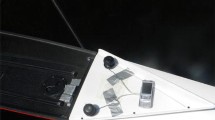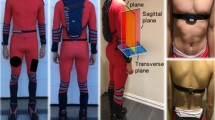Abstract
A significant number of rowers do not receive technical coaching. However, proper technique is a key component both for achieving competitive success and in preventing injuries or long-term induced postural deformity. In cooperation with national rowing coaches we developed a sensor system to continuously monitor rowers’ seat positions, enabling us to evaluate their rowing technique. We use offline data analysis, which complements existing state-of-the art methods based on video footage. Both quantitative analyses for coaches as well as qualitative and visual feedback for athletes is provided. We evaluated the accuracy of the SonicSeat system in a lab environment and obtained mean relative errors between 0.74 and 2.36 % for all but one of our performance metrics. We tested our system on the water and present exemplary data and analyses.










Similar content being viewed by others
Notes
The Fédération Internationale des Sociétés d’Aviron (FISA) is the international rowing federation.
References
Altenburg D, Mattes K, Steinacker J (2008) Handbuch Rudertraining, Limpert
BritishRowing (2011) The perfect stroke. http://www.britishrowing.org
Davoodi R, Andrews B, Wheeler G (2002) Automatic finite state control of fes-assisted indoor rowing exercise after spinal cord injury. Neuromodulation: technology at the neural. Interface 5(4):248–255
Devantech (2012) Ultra sonic range finder srf08, technical specification. http://www.robot-electronics.co.uk/htm/srf08tech.html
FISA Rule Book (2011) http://www.worldrowing.com/fisa/resources/rule-books
Franke T, Pieringer C, Lukowicz P (2011) How should a wearable rowing trainer look like? A user study. In: Proceedings of the 2011 15th Annual International Symposium on Wearable Computers, IEEE Computer Society, pp 15–18
Fritsch W (2005) Das grosse Buch vom Rennrudern, Meyer
Gravenhorst F, Tessendorf B, Arnrich B, Tröster G (2011) Analyzing rowing crews in different rowing boats based on angular velocity measurements with gyroscopes. In: International Symposium on Computer Science in Sport (IACSS 2011)
Gravenhorst F, Tessendorf B, Tröster G (2011) Towards a rowing technique evaluation based on oar orientation. In: International Conference on Pervasive Computing (Pervasive 2011)
Gravenhorst F, Thiem C, Tessendorf B, Adelsberger R, Arnrich B, Tröster G (2012), Sonicseat: a seat position tracker based on ultrasonic sound measurements for rowing technique analysis. In: Proceedings of the 7th International Conference on Body Area Networks (Bodynets)
Kleshnev V (2010) Boat acceleration, temporal structure of the stroke cycle, and effectiveness in rowing. Proc Inst Mech Eng Part P J Sports Eng Technol 224(1):63–74
NK (2012) Nielsen kellermann. http://www.nkhome.com
Smith R, Loschner C (2002) Biomechanics feedback for rowing. J Sports Sci 20(10):783–791
Tessendorf B, Gravenhorst F, Arnrich B, Tröster G (2011) An imu-based sensor network to continuously monitor rowing technique on the water. In: Proceedings of the Seventh International Conference on Intelligent Sensors, Sensor Networks and Information Processing (ISSNIP 2011), IEEE press
Togliatti EM, Derringer KS (2012) Rowing statistics. http://www.bhfinder.com/Rowing-Statistics
von Zitzewitz J, Wolf P, Novakovic V, Wellner M, Rauter G, Brunschweiler A, Riener R (2008) Real-time rowing simulator with multimodal feedback. Sports Technol 1(6):257–266
Acknowledgments
The authors would like to thank Georg Rauter, Roland Sigrist and Prof. Roland Riener from Sensory Motor Systems Lab., ETH Zurich, Switzerland for their dedicated support in the recording of the optical motion tracking data. Further thanks go to all participants of the studies and pre-studies, and the collaborating coaches for their feedback. Last but not least, thanks to Rosa Brown (topproofreading.com) for proofreading the manuscript.
Author information
Authors and Affiliations
Corresponding author
Rights and permissions
About this article
Cite this article
Gravenhorst, F., Thiem, C., Tessendorf, B. et al. SonicSeat: design and evaluation of a seat position tracker based on ultrasonic sound measurements for rowing technique analysis. J Ambient Intell Human Comput 6, 613–622 (2015). https://doi.org/10.1007/s12652-013-0216-5
Received:
Accepted:
Published:
Issue Date:
DOI: https://doi.org/10.1007/s12652-013-0216-5




